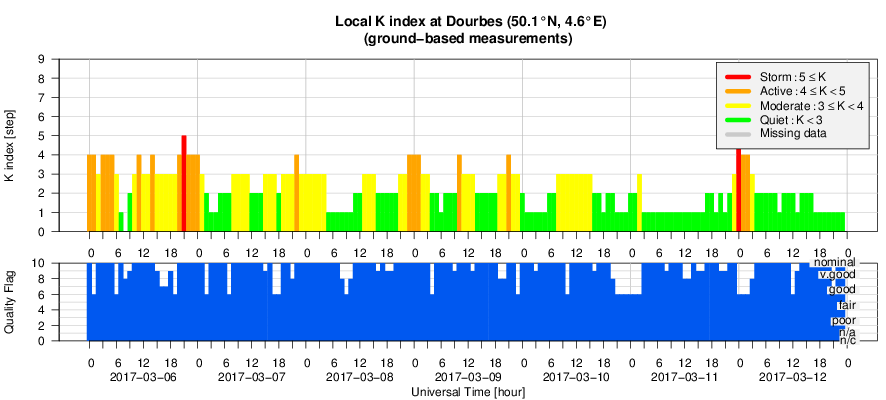- Table of Content
- 1.Ghost flares
- 2.CHARMing!
- 3.PROBA2 Observa...
- 4.Review of sola...
- 5.The Internatio...
- 6.Review of geom...
- 7.Geomagnetic Ob...
- 8.Review of iono...
- 9.Future Events
2. CHARMing!
3. PROBA2 Observations (6 Mar 2017 - 12 Mar 2017)
4. Review of solar activity
5. The International Sunspot Number
6. Review of geomagnetic activity
7. Geomagnetic Observations at Dourbes (6 Mar 2017 - 12 Mar 2017)
8. Review of ionospheric activity (6 Mar 2017 - 12 Mar 2017)
9. Future Events
Ghost flares
Satellites watch the Sun 24/7 for bursts of light that happen on the Solar surface. Computers help to analyse the numerous satellite data to identify these solar flares.
So far so good. As we are heading to a so-called Solar Minimum in which the Sun expels less energy in the form of particles and light and the Sun looks less complicated, the continuous output of light has diminished and reached a very low level at the moment. This is not exceptional since the Sun plunges into a minimum every 11 years.
One could think that these Solar condition are easier to monitor and to analyse. However, these low levels can create complications as the influence of measurement noise becomes more pronounced.
The recent false flare detections noted by the Space Weather Forecast Centre of Belgium are a good example. Jesse Andries, head of the forecast centre explains "The X-ray measurements by the NOAA/GOES satellites are in general taken as the reference to quantify solar flares. But we recently saw ‘ghost' bursts being reported based on the GOES13 data. Closer inspection and comparison with the data of GOES15 as well as with the data from the LYRA instrument on board the PROBA2 satellite which we operate ourselves, shows that these were indeed false detections. Apparently they are caused by automated routines working on data with large noise levels."
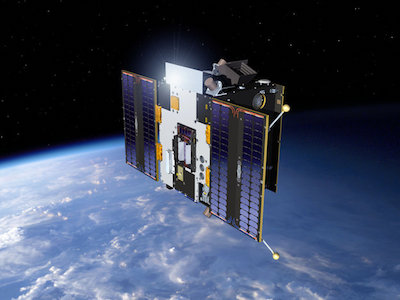
Jesse Andries concludes "Our forecasters are always aware of possible fake events in the reference lists. It is our second nature to check and re-check the original data and compare it with other observations. It illustrates the benefit of being closely connected with the instruments, as we are with LYRA. It allows us to check every step in the chain and to come to trustworthy results."
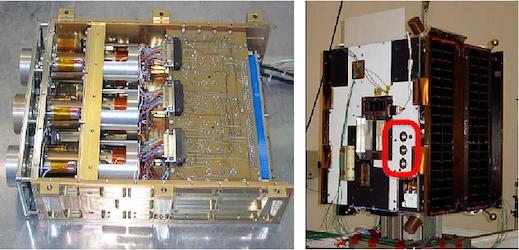
LYRA is a radiometer onboard of the ESA micro satellite PROBA2 that is in space since 2009: http://proba2.oma.be
Check the Space Weather Forecast Center: http://www.sidc.be
CHARMing!
Back in 2012, under impulse from BELSPO (BELgian federal Science Policy Office), 5 Belgian research teams (KUL, ULB, UGent, ROB and BISA) and two renowned international partners (Durham, Leiden) joined forces to investigate Contemporary physical challenges in Heliospheric and AstRophysical Models (CHARM). This unified effort aims at identifying common grounds across disciplines that vary from solar, magnetospheric and heliospheric, to galactic or cosmologically driven curiosities. These common grounds are found in the high performance computing approaches, in the challenges when confronting models with observations, and in the most enigmatic aspects of the physical processes at work. More info on the CHARM project is at http://wis.kuleuven.be/CHARM
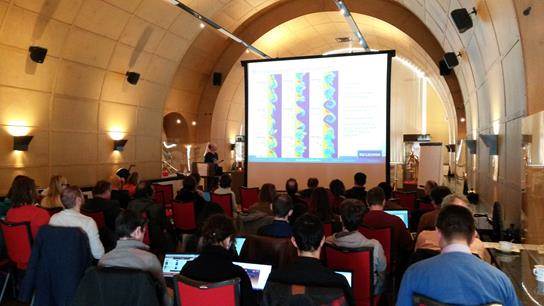
The 2017 annual CHARM meeting took place in the Meridian Room of the Royal Observatory of Belgium on 10 March. The purpose of the meeting was to review the ongoing activities at the 7 CHARM partners up till the end of the CHARM project later in 2017. Nearly 40 (!) participants indulged themselves in the most profound aspects of magnetohydrodynamic (MHD) turbulence, Kelvin-Helmholtz instabilities, particle acceleration in explosive reconnection, quasi-periodic pulsations in solar flares, mesh-free Hamiltonians (I'm not making this up!), accretion of clumpy wind in SGXB,... and much more!
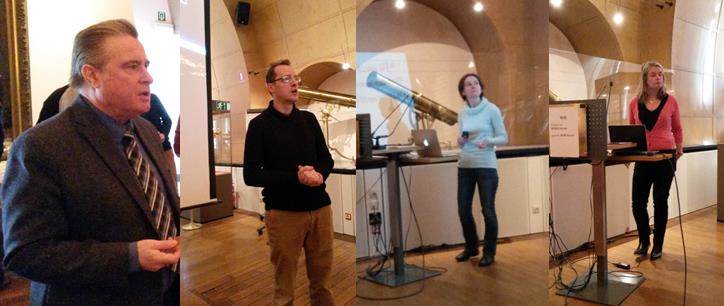
No less than 16 presentations were given (https://events.oma.be/indico/event/27/ ), each lasting 15-20 minutes and topped off with a round of Questions and Answers. The logistical support was of the same high level, and it is rumored that the number of sandwiches and liters of coffee were probably high enough to start a physics model on its own!
CHARM is part of the Interuniversity Attraction Poles (IAP - http://www.belspo.be/iap/ ), a federal programme that will end this year. A successor has been developed on regional level: EOS (Excellence of Science - http://www.fwo.be/en/fellowships-funding/research-projects/eos-research-project/ ). The EOS-programme wants to promote joint research between researchers in the Flemish and French-speaking community by funding joint fundamental research projects in any scientific discipline. If CHARM gets selected, it will be able to continue its important role in bringing researchers from various domains together to find common grounds for further collaboration.
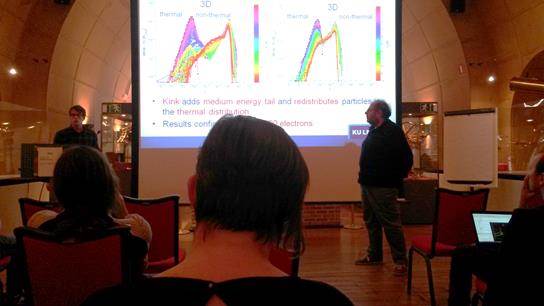
PROBA2 Observations (6 Mar 2017 - 12 Mar 2017)
Solar Activity
Solar flare activity remained very low during the week.
In order to view the activity of this week in more detail, we suggest to go to the following website from which all the daily (normal and difference) movies can be accessed: http://proba2.oma.be/ssa
This page also lists the recorded flaring events.
A weekly overview movie can be found here (SWAP week 363):
http://proba2.oma.be/swap/data/mpg/movies/weekly_movies/weekly_movie_2017_03_06.mp4
Details about some of this week's events, can be found further below.
If any of the linked movies are unavailable they can be found in the P2SC movie repository here:
http://proba2.oma.be/swap/data/mpg/movies/
Monday Mar 06
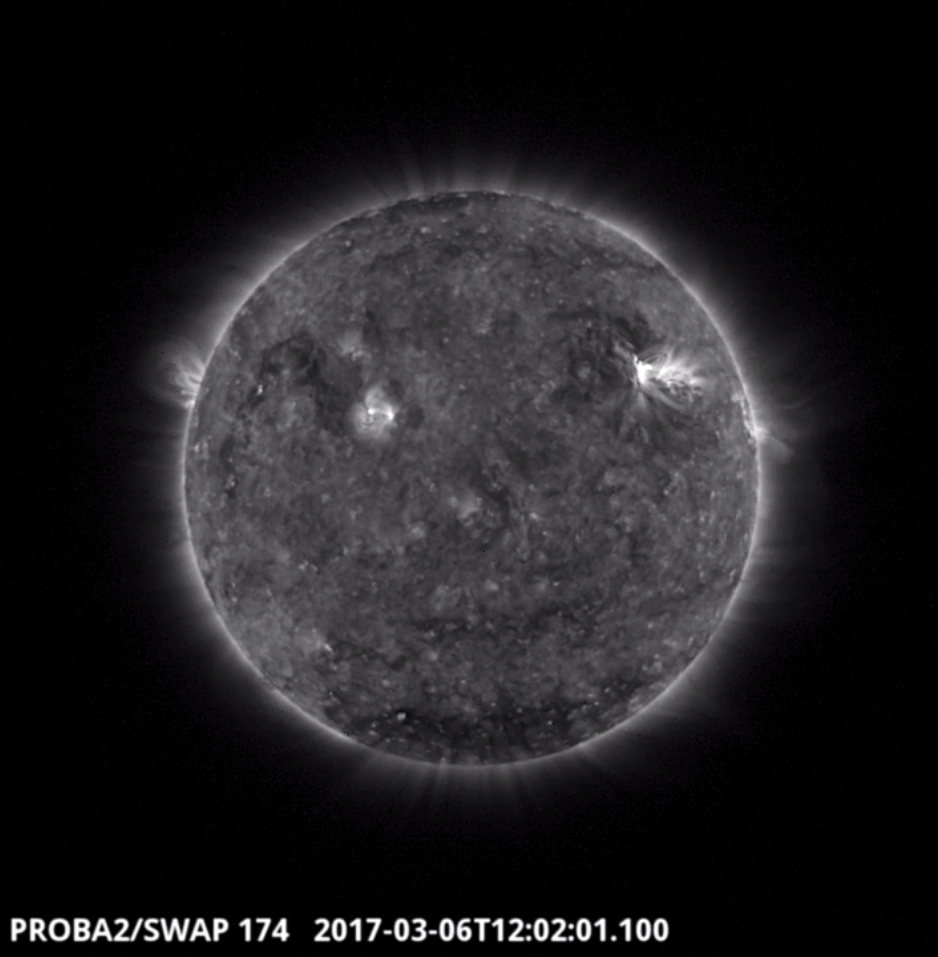
A flare (B1.5 class) produced by AR 2641 was observed by SWAP on 2017-Mar-06 shown here in the western hemisphere of the Sun at 12:02 UT.
Find a movie of the events here (SWAP movie):
http://proba2.oma.be/swap/data/mpg/movies/20170306_swap_movie.mp4
Sunday Mar 12
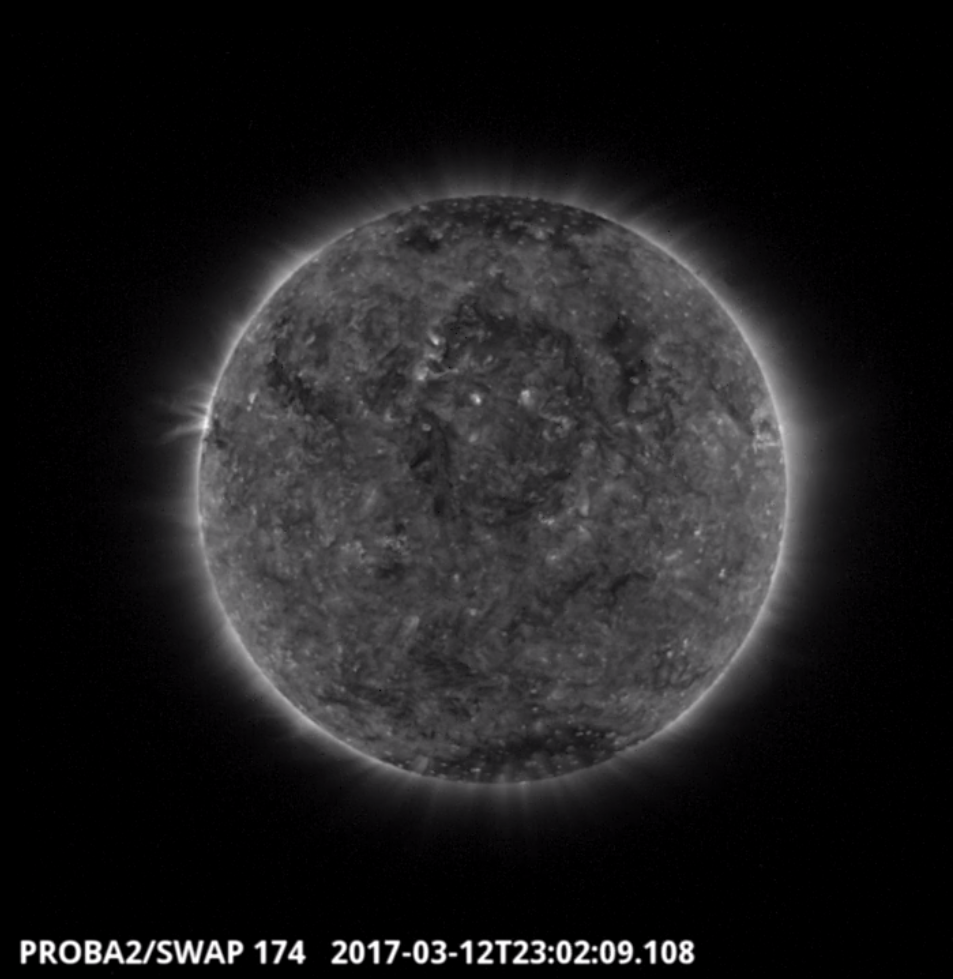
The solar activity remained very low over the week and for periods there were no sunspots visible on the solar disk. An example of the quiet Sun is shown here on 2017-03-12.
Review of solar activity
Solar activity was very low. The Sun was spotless all week. The greater than 10MeV proton flux was at nominal levels.
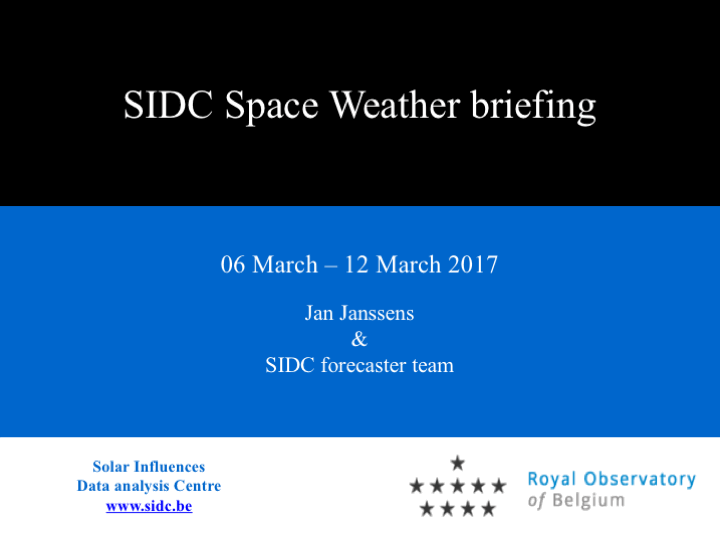
No earth-directed coronal mass ejections (CMEs) were observed in available coronagraphic imagery.
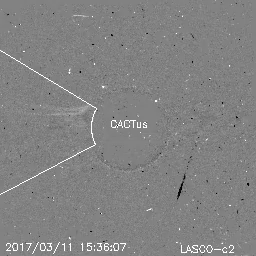
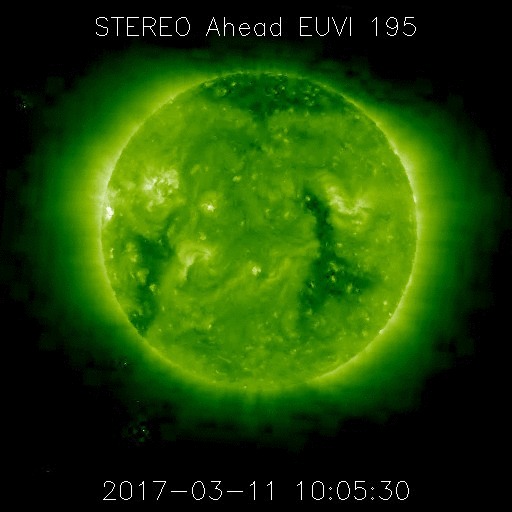
A narrow extension of the northern positive polar coronal hole (CH) was at the Central Meridian on 10 March.
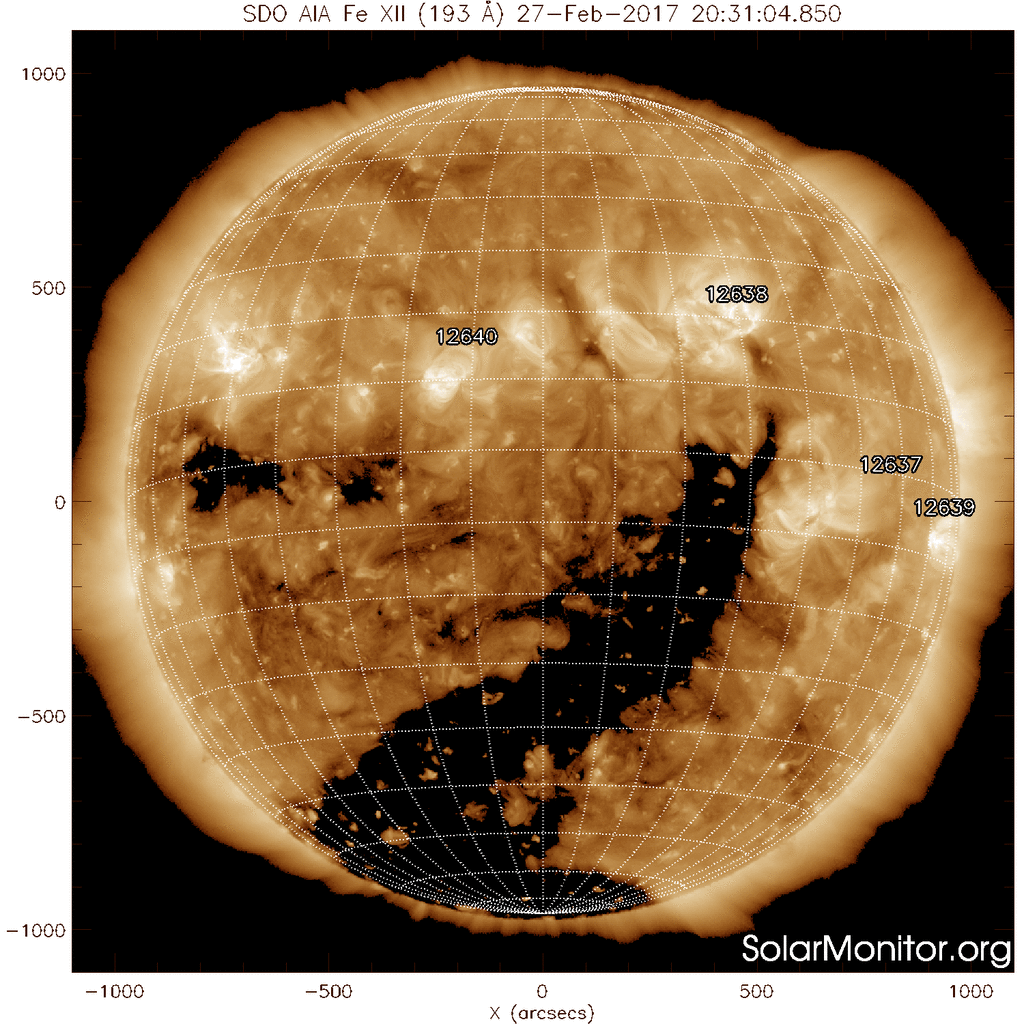
The International Sunspot Number
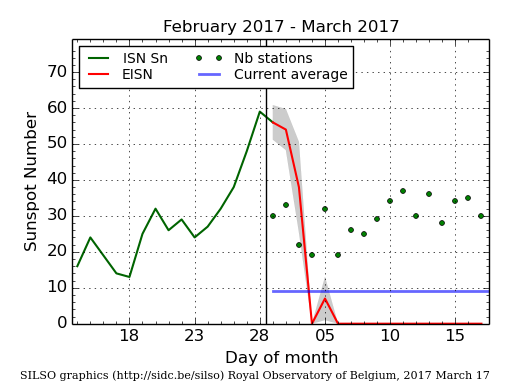
The daily Estimated International Sunspot Number (EISN, red curve with shaded error) derived by a simplified method from real-time data from the worldwide SILSO network. It extends the official Sunspot Number from the full processing of the preceding month (green line). The plot shows the last 30 days (about one solar rotation). The horizontal blue line shows the current monthly average, while the green dots give the number of stations included in the calculation of the EISN for each day.
Review of geomagnetic activity
The earth environment was under the influence of the high speed stream (HSS) from the extension of the negative southern polar coronal hole (CH) from 6 till 10 March. Solar wind speed gradually declined from an initial 650 km/s to 470 km/s late on 10 March, then declining further to values near 350 km/s by the end of the period. Bz oscillated mostly between -6 nT and +6 nT. The interplanetary magnetic field was mostly directed towards the Sun, with some brief positive sectors (away) on 10 March and again late on 11 March.
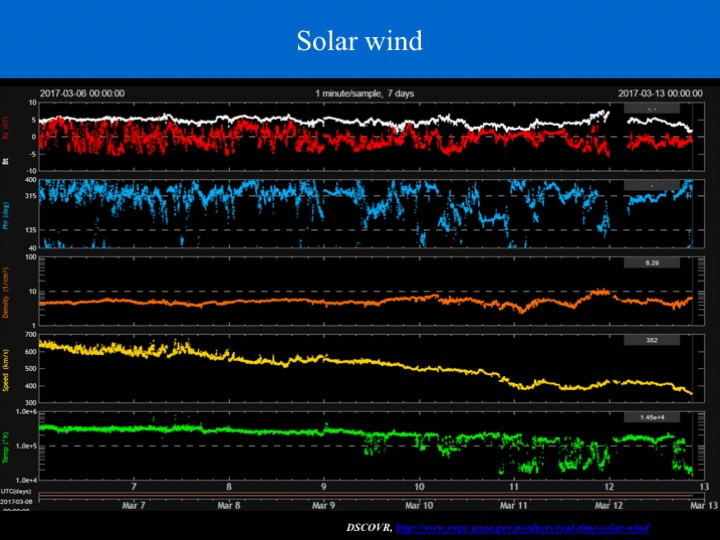
Except for an isolated minor storming episode on 6 and 11 March, quiet to active geomagnetic conditions were observed, with the number of active intervals becoming less frequent towards the end of the week.
Review of ionospheric activity (6 Mar 2017 - 12 Mar 2017)
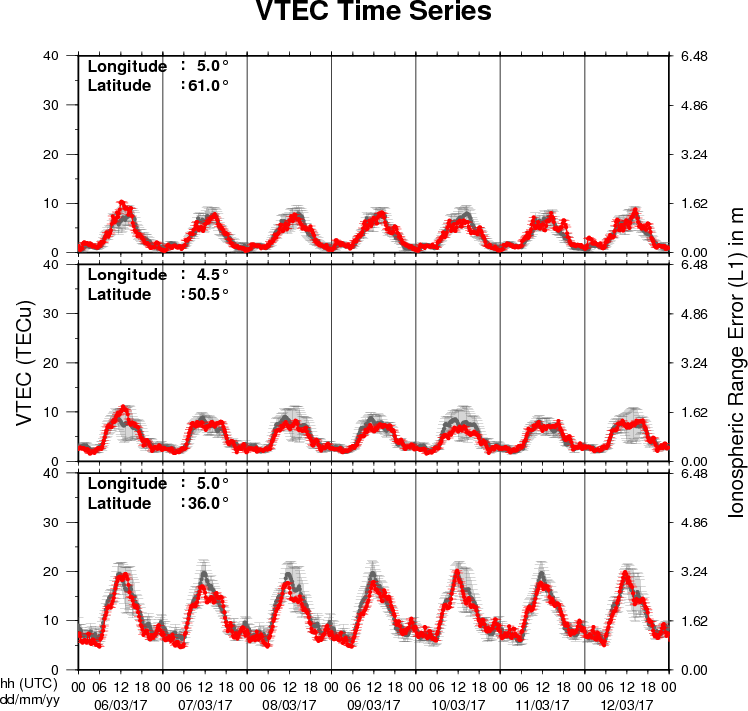
The figure shows the time evolution of the Vertical Total Electron Content (VTEC) (in red) during the last week at three locations:
a) in the northern part of Europe(N61°, 5°E)
b) above Brussels(N50.5°, 4.5°E)
c) in the southern part of Europe(N36°, 5°E)
This figure also shows (in grey) the normal ionospheric behaviour expected based on the median VTEC from the 15 previous days.
The VTEC is expressed in TECu (with TECu=10^16 electrons per square meter) and is directly related to the signal propagation delay due to the ionosphere (in figure: delay on GPS L1 frequency).
The Sun's radiation ionizes the Earth's upper atmosphere, the ionosphere, located from about 60km to 1000km above the Earth's surface.The ionization process in the ionosphere produces ions and free electrons. These electrons perturb the propagation of the GNSS (Global Navigation Satellite System) signals by inducing a so-called ionospheric delay.
See http://stce.be/newsletter/GNSS_final.pdf for some more explanations ; for detailed information, see http://gnss.be/ionosphere_tutorial.php
Future Events
For more details, see http://www.spaceweather.eu/en/event/future
International CCMC-LWS Workshop in Cape Canaveral, Florida (USA)
Start : 2017-04-03 - End : 2017-04-07
The goal of this working meeting is to address the need to
quantify and to track progress over time in the field of space
weather and to establish internationally recognized metrics that
are meaningful to end-users and developers. Defining a set of
appropriate metrics is important to track advancements in space
weather understanding and predictive capabilities.
This meeting is a part of the unfolding activities of the
International Forum for Space Weather Capabilities Assessment that
brings together space environment experts, model and application
developers, data providers, forecasters and end-users. The goals of
this community-wide forum include addressing challenges in
model-data comparisons and evaluating the current state of space
environment predictive capabilities. Workshop attendance is
encouraged but is not a requirement for joining forum teams.
Website:
http://ccmc.gsfc.nasa.gov/CCMC-LWS_Meeting/
Solar Orbiter Workshop 7: Exploring the solar environs in Granada, Spain
Start : 2017-04-03 - End : 2017-04-06
This event will be hosted by the Instituto de Astrofisica de
Andalucia - CSIC. Please mind that on April 7th the 20th SWT
meeting will take place at the same venue.
Website: Unkown
URSI General Assembly in Montreal, Canada
Start : 2017-08-19 - End : 2017-08-26
For the thirty-second time since the inception of URSI, Radio
Scientists from across the world will get together for the URSI
General Assembly and Scientific Symposium. This triennial gathering
will take place from 19th to 26th of August 2017, in Montreal,
Canada. This conference is a unique opportunity to learn about
recent advances in all fields of Radio Science, as covered by all
ten URSI Commissions.
Among the different sessions, please note:
* 'Radio Science for Space Weather'
Conveners: M. Messerotti, V. Pierrard
* 'Remote Sensing and Modeling of the Earth's Plasmasphere
and Plasmapause'
Conveners: A. M. Jorgensen, V. Pierrard, B. Heilig
The abstract deadline is 30 January 2017
Website: http://www.ursi2017.org
2017 Joint IAPSO-IAMAS-IAGA Assembly in Cape Town, South Africa
Start : 2017-08-27 - End : 2017-09-01
The Joint IAPSO-IAMAS-IAGA Assembly, endorsed by the University
of Cape Town and the South African Department of Science and
Technology, will take place from 27 August to 1 September 2017 at
the Cape Town International Convention Centre (CTICC). Several IAGA
and IAMAS sessions are of Space Weather interests as well as the
joint session 'Space Weather throughout the Solar System: Bringing
Data and Models together'.
Website:
http://iapso-iamas-iaga2017.com/index.php
Workshops on Radiation Monitoring for the International Space Station in Torino, Italy
Start : 2017-09-05 - End : 2017-09-07
The Workshop on Radiation Monitoring for the International Space
Station is an annual meeting to discuss the scientific definition
of an adequate radiation monitoring package and its use by the
scientific community on the ISS. Types of instruments and research
topics need to be defined in order to optimise the radiation safety
of the ISS crew.
Website: http://wrmiss.org/
European Space Weather Week 14
Start : 2017-11-27 - End : 2017-12-01
The ESWW is the main annual event in the European Space Weather
calendar. It is the European forum for Space Weather as proven by
the high attendance to the past editions. The agenda will be
composed of plenary/parallel sessions, working meetings and
dedicated events for service end-users. The ESWW will again adopt
the central aim of bringing together the diverse groups in Europe
working on different aspects of Space Weather.
Website:
http://www.stce.be/esww14/
